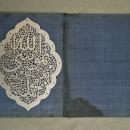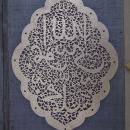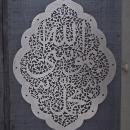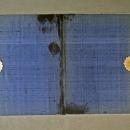Antique 16th-17th century Persian Safavid Islamic Cut Steel Panel








$6,000.00
Very rare museum quality antique 16th- 17th century, Persian Safavid dynasty, Islamic cut steel panel, made of hand forged patterned crucible steel (wootz steel) in the form of an elaborate cartouche of lobed ovoid form.
The panel is finely hand pierced with elegant inscriptions in Arabic calligraphic Thuluth script:
الله Allah. موسى Musa (Moses). محمد Muhammad, amidst scrolling vines issuing flower heads and split palmettes in a distinguishing Safavid Persian pattern of interlocking split-leaf arabesques within a broad border, pierced with 12 unregular nail holes to be nailed on the home doorway.
This panel with the word God and the names of these two profits served as an apotropaic device, protecting the house from evil influences, deflecting misfortune, and averting the power of evil, guarantee the personal safety of the house's inhabitants and the blessings of Allah.
The surface on both sides of the panel displays a superb fine "grain" Wootz pattern.
The panel is housed in a 19th century cardboard folder bound in a hand woven light blue raw silk fabric with a closure made of gold braided metallic cord.
This beautiful panel is made of hand forged ultra-high carbon (UHC) patterned crucible steel (wootz) and is finely finished with a perfectly smooth exterior surface, and hammering marks are not visible.
For several decades, the market has been flooded with reproductions of Islamic, Persian, and Indian art objects, including metal and jade works, arms, armor, ceramics, etc. Many of these reproductions of Islamic art objects, including reproductions of Persian Safavid cut steel panels, are made of modern steel, not stiff, inflexible, crucible steel. Some of the objects made currently by Indian artisans are very well made, professionally aged, rusted, and damaged to look old.
To inexperienced collectors and auctioneers, these reproductions look like genuine artifacts. However, professional subject matter experts can tell the difference between reproductions and original objects.
These reproductions have no historical or investment value.
We would like to inform you that this is a 100% authentic, antique steel panel from the 16th-17th century of the Persian Safavid dynasty, made of stiff crucible steel and is accompanied by a Certificate of Authenticity.
PROVENANCE: from an old Canadian collection of antiques.
MEASUREMENTS:
Dimensions: 33.8 cm x 24.5 cm (13.31 x 9.65 inches).
Dimensions of the folder: 38 cm x 27 cm (14.96 x 10.63 inches).
CONDITION: very good condition, no cracks, repairs, or missing parts.
Blue silk fodder shows age and use, stained, with worn edges.
Technically steel panels of this type required great skill to make. First a master-scribe would have copied the inscription on paper and transferred it to the steel by means of a stencil or pounce. The metalworker would then need to capture the elegance of the calligraphy with what were a cumbersome set of tools - something he clearly performed with the utmost skill. Crucible Steel being primarily used for weapons, it is likely that the maker was a swordsmith trained in the discipline of cutting and forging pattern-welded steel. Esin Atil, when writing about a similar panel exhibited in 'The Unity of Islamic Art' writes that "steel reached a peak of decorative perfection under the Safavids in the 16th and 17th centuries" (Esin Atil, The Unity of Islamic Art, exhibition catalogue, Riyadh, 1985, no. 96, pp.120-21). A similar panel to those offered here is in the British Museum (The Arts of Islam, exhibition catalogue, London, 1976, no.235, p.200).
Analytical and microstructural approach to the study of historical ultra-high carbon (UHC) steel plaques belong to the Malek National Library and Museum Institution, Iran.
Highlights:
Safavid openwork steel plaques have been made of Ultra-high carbon (UHC) steel.
Divorced eutectoid transformation (DET) has been used in manufacturing process.
Cementite particles in the ferrite and pearlite background were identified.
Complicated forging/heating cycles have been used for producing steel plaques.
Some plaques have been quenched in the middle of phase transition termed DET.
A number of steel plaques in Iran belong to Safavid period (17th century) were examined for their chemical composition and microstructure. The artefacts were analyzed using micro-PIXE, SEM-EDS and reflected light microscopy (OM). According to SEM-EDS and micro-PIXE analyses, it was revealed that the plaques were made of mostly pure iron (approximately 99 wt%). Presence of trace amounts of manganese, sulfur, chromium, silicon, titanium and potassium were identified in the plaques. Metallographic investigation showed that the plaques were made of hypereutectoid steel with a microstructure consisting of spherical particles of carbide in the ferrite and pearlite background. Moreover, the use of ultra-high carbon (UHC) steel with microstructure of pearlite matrix and needle-like Widmanstätten cementite was identified in one plaque. These features showed that Safavid plaques have been made of crucible steel. In addition, it demonstrated that complicated forging/heating cycles have been used for manufacturing of these openwork steel plaques. It was also revealed that in addition to arms and armors, crucible steel has served as an everyday work material in Safavid period in Iran.
Please see the link below:
https://www.sciencedirect.com/science/article/abs/pii/S1044580316301383
REFERENCES:
Similar Panel is published in "Le Chant du monde: l'art de l'Iran safavide, 1501-173" by Assadullah Souren Melikian-Chirvani. Musée du Louvre à Paris. No. 14-15.
A few related panels remain in the collection of the most important world museums, including the Musée du Louvre, the British Museum, and the Cleveland Museum of Art.
Please see the links below.
https://collections.louvre.fr/en/ark:/53355/cl010319827
https://www.britishmuseum.org/collection/object/W_OA-368
https://www.clevelandart.org/art/1994.1
Only a few similar plaques appeared over the years for sale in the Sotheby's, Christie's, and Bonhams auctions.
Please view the links below:
Sotheby's, London. Arts Of The Islamic World. 01 April 2009.Lot .111.
Link: http://www.sothebys.com/en/auctions/ecatalogue/2009/arts-of-the-islamic-world-l09721/lot.111.html
Christie's, South Kensington. The Saeed Motamed Collection Part I.22 April 2013.Lot.125
Link: https://www.christies.com/lot/lot-5671294?ldp_breadcrumb=back&intObjectID=5671294&from=salessummary&lid=1
Bonhams, London, Islamic and Indian Art.18 October 2016. Lot. 98.
Link: https://www.bonhams.com/auction/23437/lot/98/a-fine-safavid-pierced-steel-plaque-with-the-names-of-the-first-four-caliphs-persia-dated-ah-972ad-1564-65/
Christie's, London. Art of the Islamic and Indian Worlds.20 October. 2016.Lot.35.
Link: https://www.christies.com/lot/lot-6024713?ldp_breadcrumb=back&intObjectID=6024713&from=salessummary&lid=1
Bonhams, London, Islamic and Indian Art.6 October 2015. Lot.45.
https://www.bonhams.com/auction/22816/lot/45/a-safavid-pierced-gilt-steel-plaque-persia-dated-ah-1109ad-1697-98/







